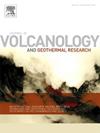Eruptive dynamics of open-vent andesitic volcanoes retrieved from petrological and componentry analysis of recent explosive phases (2020−2022) of Sangay (Ecuador)
IF 2.4
3区 地球科学
Q2 GEOSCIENCES, MULTIDISCIPLINARY
Journal of Volcanology and Geothermal Research
Pub Date : 2025-02-01
DOI:10.1016/j.jvolgeores.2024.108238
引用次数: 0
Abstract
Since its reawakening in 2019, Sangay volcano (Ecuador) experienced a continuous, low magnitude eruptive activity that was disrupted by some mild-explosive pulses. Andean communities in central Ecuador and the Guayaquil International Airport have been affected by the ash fallouts. Through componentry, geochemical and petrological analysis, we studied ash and lapilli samples, emitted during the mild-explosive eruptions of 2020–2021 and during the minor eruptions of 2022, to document the changes in eruptive dynamics, constrain the pre-eruptive physical conditions, and identify the potential triggering mechanisms. Major elements whole-rock compositions show a progressive decrease in silica content, from andesitic to basaltic andesitic compositions, and a concomitant increase in magnesium content over time. Componentry, textures and chemical variations in groundmass glass support the idea that Sangay's shallow plumbing system hosts magmas that have evolved in composition, having variable physical properties that control the eruptive dynamics. The change in eruptive style towards more explosive dynamics in 2020–2021 was probably associated with the feeding of a more mafic and gas-rich magma from deep. The consequence, reflected in the groundmass glass chemistry and componentry data, is the “excavation” of the partially crystallized magma stalling in the conduits, which led to the observation of the more diverse compositions in the juvenile material. This work contributes to a better understanding of the eruptive behavior of long-lived, open-vent andesitic volcanoes, and to explore the link between eruptive dynamics and the petrological evolution of magmas.

从桑格(厄瓜多尔)最近爆发期(2020 - 2022)的岩石学和成分分析中获取的开孔安山岩火山喷发动力学
自2019年重新苏醒以来,桑格火山(厄瓜多尔)经历了持续的低震级喷发活动,并被一些轻度爆炸脉冲打断。厄瓜多尔中部的安第斯社区和瓜亚基尔国际机场受到火山灰沉降物的影响。通过组分、地球化学和岩石学分析,研究了2020-2021年轻度喷发和2022年轻度喷发期间的火山灰和石蜡样品,记录了喷发动力学的变化,约束了喷发前的物理条件,并确定了潜在的触发机制。主要元素全岩组成显示出从安山岩到玄武岩的硅含量逐渐减少,镁含量随时间的增加而增加。地面玻璃的成分、质地和化学变化支持了这样一种观点,即桑格浅层管道系统中的岩浆在成分上已经进化,具有控制喷发动力学的可变物理特性。在2020-2021年,喷发方式向更具爆炸性的动态变化可能与来自深部的更具基性和富含气体的岩浆的补给有关。其结果,反映在地层玻璃化学和成分数据中,是部分结晶岩浆在管道中被“挖掘”,从而导致在幼体物质中观察到更多样化的成分。这项工作有助于更好地理解长寿命、开孔安山岩火山的喷发行为,并探索喷发动力学与岩浆岩石学演化之间的联系。
本文章由计算机程序翻译,如有差异,请以英文原文为准。
求助全文
约1分钟内获得全文
求助全文
来源期刊
CiteScore
5.90
自引率
13.80%
发文量
183
审稿时长
19.7 weeks
期刊介绍:
An international research journal with focus on volcanic and geothermal processes and their impact on the environment and society.
Submission of papers covering the following aspects of volcanology and geothermal research are encouraged:
(1) Geological aspects of volcanic systems: volcano stratigraphy, structure and tectonic influence; eruptive history; evolution of volcanic landforms; eruption style and progress; dispersal patterns of lava and ash; analysis of real-time eruption observations.
(2) Geochemical and petrological aspects of volcanic rocks: magma genesis and evolution; crystallization; volatile compositions, solubility, and degassing; volcanic petrography and textural analysis.
(3) Hydrology, geochemistry and measurement of volcanic and hydrothermal fluids: volcanic gas emissions; fumaroles and springs; crater lakes; hydrothermal mineralization.
(4) Geophysical aspects of volcanic systems: physical properties of volcanic rocks and magmas; heat flow studies; volcano seismology, geodesy and remote sensing.
(5) Computational modeling and experimental simulation of magmatic and hydrothermal processes: eruption dynamics; magma transport and storage; plume dynamics and ash dispersal; lava flow dynamics; hydrothermal fluid flow; thermodynamics of aqueous fluids and melts.
(6) Volcano hazard and risk research: hazard zonation methodology, development of forecasting tools; assessment techniques for vulnerability and impact.

 求助内容:
求助内容: 应助结果提醒方式:
应助结果提醒方式:


